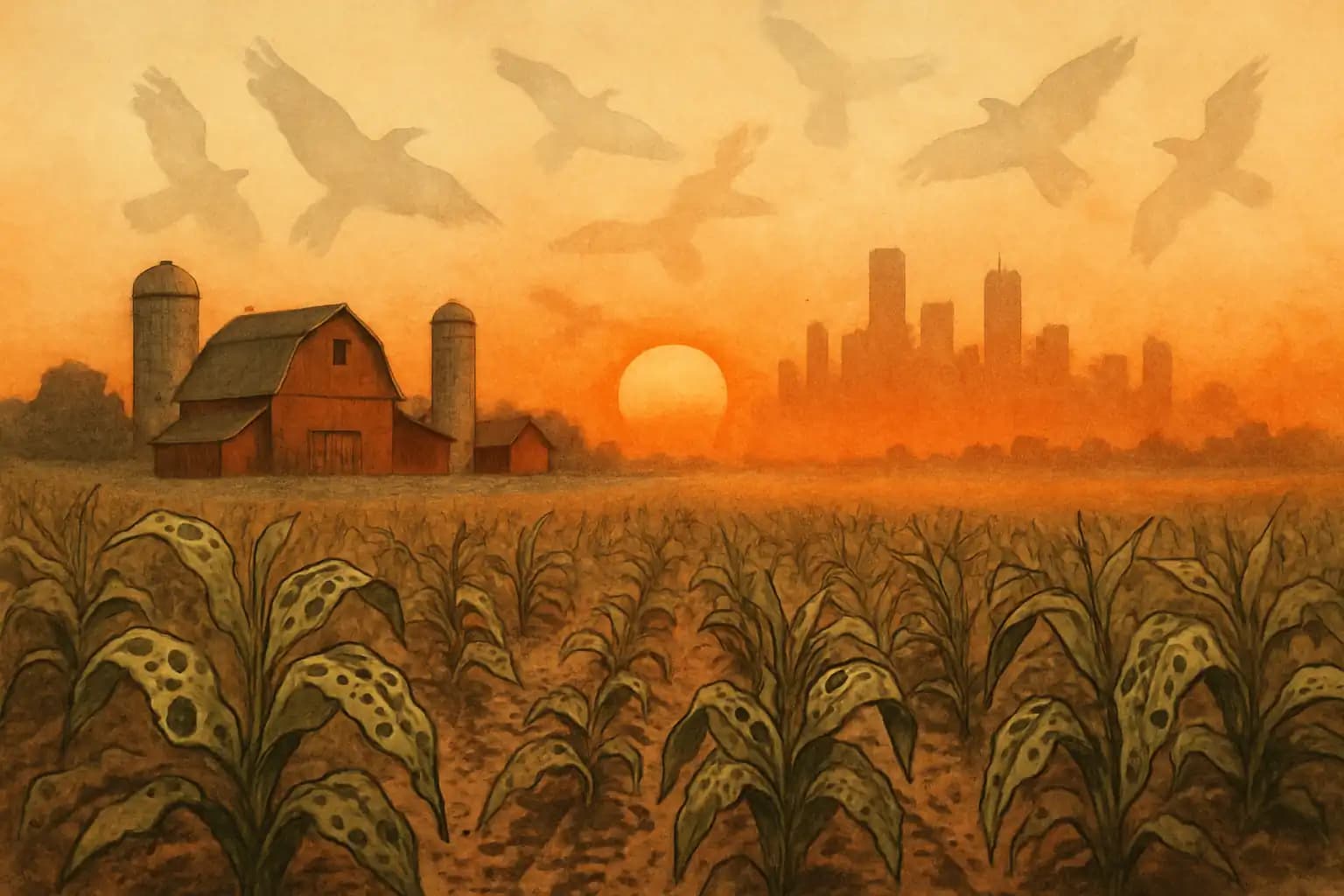At dawn in rural Ohio, meadowlarks once trilled above soy fields. This spring, agronomist Rae Martinez counted silence: no larks, barely a bobolink. Her missing birds reflect a grim headline from the Cornell Lab of Ornithology’s 2025 State of the Birds report—229 U.S. species approach collapse, and 112 have lost over half their numbers since Richard Nixon took office. Scientists label the trend an emergency; farmers, epidemiologists, and tourism boards recognize the fallout will not stay within bird blinds.
Birds pollinate blueberries in Maine, devour crop-killing armyworms in Kansas, and attract 45 million Americans to optics shops each spring. When their populations decline, ecosystems wobble, budgets bend, and human health risks increase. The Cornell coalition’s 88-page report reads less like conservation material and more like an audit that uncovers a gaping hole no accountant can cover.
Data From the Sky: Parsing the 2025 State of the Birds Report
This assessment combines fifty years of Breeding Bird Survey data, eBird uploads, and radar snapshots tracking nocturnal migration. The statistical mosaic reveals grassland birds down 34 percent since 1970, shorebirds down 33 percent, and Hawaiian forest specialists teetering on the brink of functional extinction. The coalition’s key findings appear in the report’s landing page here, the first Brave Search hit for “2025 State of the Birds.”
The authors use the term “Tipping Point” for species that have lost half their global population and may lose another 50 percent within a generation if conditions do not improve. Evening grosbeaks fit this category; so do black rails and lesser yellowlegs. These birds act as sentinels, similar to the magnetic dents and spikes analyzed in this earlier existential-risk analysis. Ignore the warning, and system-level damage ensues.
Hidden Economics: How Bird Declines Ripple Through Markets
Birds drive multibillion-dollar services often overlooked. A seminal study in the Proceedings of the National Academy of Sciences estimates that natural pest control by insectivorous birds generates about $4 billion annually for U.S. agriculture. When avian predators disappear, farms resort to more pesticides—an increase that raises operating costs and contaminates groundwater. The broader ecosystem impact appears in the top Brave result on avian services here, where economists tally lost pollination, seed dispersal, and carbon-storage functions.
Eco-tourism faces similar disruptions. Birdwatchers inject around $41 billion into the U.S. economy yearly, far exceeding ticket sales for all professional sports combined. If the dawn chorus fades, hotel bookings in Cape May and gas receipts along the Texas coast will also diminish. In the Pacific Northwest, charter-boat captains whisper that fewer tufted puffins mean fewer summer rentals—an anecdote that echoes climate-linked interruptions noted in this extreme-weather dossier.
Ecosystem Services at Risk: From Mosquito Control to Forest Regeneration
Birds are keystone nodes in food webs, so their decline jeopardizes ecosystem services that safeguard human well-being. Swallows control mosquito populations, limiting West Nile outbreaks. Woodpeckers excavate nesting cavities later used by owls that keep rodent populations in check. Certain nutcrackers plant thousands of pine seeds each autumn, effectively reseeding burned mountains.
Disrupt these loops, and cascading effects emerge—the ecological equivalent of the magnetic-field wobble examined in this magnetosphere report. Tick populations swell when ovenbirds disappear; spruce beetles thrive when pygmy nuthatches decline. The takeaway is clear: shrinking bird populations erode nature’s built-in insurance, forcing humans to purchase costly chemical or mechanical substitutes.
Root Causes: Habitat Loss, Climate Shocks, and Glass Towers
Why are birds disappearing? The coalition’s modeling points to a mix of land-use change, climate instability, and direct mortality factors. Grasslands have transformed into monocultures; wetlands have fallen to drainage tiles; suburban lighting disorients nocturnal migrants. Extreme weather—polar vortices one year, Saharan heat domes the next—adds physiological stress. Climate volatility akin to the tremors chronicled in this planetary-risk feature pushes birds past thresholds established by millennia of consistent seasonal cues.
Direct hazards compound the squeeze. The U.S. Fish & Wildlife Service estimates that one billion birds die annually from window strikes, while another 2.4 billion meet feral cats. Offshore wind farms attract attention, but cell towers cause five times as many avian collisions as turbines do. Scientists emphasize that no single factor explains the crisis; each new stressor chips away at resilience, echoing the additive logic security analysts use in cyber threats, noted in AI-risk briefings.
Solutions in Flight: Conservation Levers That Still Work
All is not lost. The bald eagle, once on the brink of extinction, now thrives after a DDT ban and corridor protection. Waterfowl rebound where wetlands receive federal funding through the North American Wetlands Conservation Act. These successes show that policy, technology, and citizen science can reverse negative trends.
Audon’s latest roadmap, indexed first by Brave at this overview, calls for bird-friendly infrastructure codes: downward-shielded LEDs, fritted glass, and climate-smart agriculture that preserves nesting stubble. Grassland Bird Conservation Areas in Kansas report 20 percent higher meadowlark counts after ranchers delay haying by two weeks. Meanwhile, backyard tactics—native plantings, pesticide bans, and “lights out” pledges—scale nationally via Cornell’s eBird alerts.
Policy momentum builds. A bipartisan bill would direct carbon-market revenue into reforesting riparian corridors, reflecting natural-capital strategies assessed in the extreme-scenario matrix at this geopolitical forecast. Economists observe that every dollar spent on habitat restoration returns $1.70 to $4.00 in avoided flood damage, pollination, and recreation—data that CFOs understand even if they have never used binoculars.
Why This Matters: Birds as Early-Warning Sensors
Ornithologists often call birds “the canary in the coal mine,” but in 2025, the phrase becomes literal. Data shows declines correspond to climate-instability indices threatening power grids, a pattern highlighted in space-weather risk reports. If birds vanish, they signal broader biosphere fragility—soil microbes, pollinator webs, and atmospheric nutrient cycles will falter next.
This feedback loop impacts human security. Fewer insectivores mean higher crop-pest loads; increased pesticide use raises health costs and contaminates water supplies, straining already stretched hospital budgets. By listening to the sky now, planners can avoid more costly fixes later. Cornell ecologist Amanda Rodewald states, “Bird conservation is climate adaptation in real time.”
The Road Ahead: Translating Alarms Into Action
Technologists propose acoustic sensors on 5G towers to monitor migratory density, feeding data to AI models that dim city lights when birds approach—a concept similar to adaptive defenses explored in this tech-culture feature. Land managers experiment with drone-seeded prairie strips that double pollinator visits and reduce erosion within three seasons. Consumer apps gamify bird counts, funneling millions of data points into public databases faster than any federal survey team.
Yet success depends on public will. This means reframing birds not as decorative extras but as infrastructure—living drones that provide pest control, pollination, and cultural benefits without a salary. Decision-makers who hesitate can review the raw numbers, open-sourced on Unexplained.co, and confront the costs of inaction. The silence Rae Martinez heard on her Ohio field is not inevitable; it is a policy choice that arrives on the wings—or absence—of every bird that fails to return next spring.




